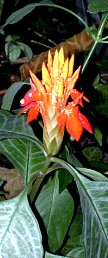 |
Let's look at roots - something that
we don't do that often unless there has been some calamity which
has tipped over a plant. |
|
Their contribution to the plant world is to hold the above-ground parts steady - picture trying to balance a 2 x 4 on end, then mentally nail it to the center of a cross composed of other timbers and see how much more stable it becomes. Now fasten the arms of the cross to the ground securely and you are starting to approximate the support which the roots give to the plant. The actual spread of many plants' roots has been measured, and it is commonplace for a tree to have roots that extend outwards from the base of the trunk to the same length as the height of the trunk. The roots may or may not go deep into the ground, but they certainly spread out through the top several inches. That is the physical side of where roots fit into the complex system that makes up a plant. Their other functions have to do with the flow of water and dissolved materials into the plant body. For most plants you would not be far wrong to say that if the roots are not working properly the plants have no chance of survival. As always in life there are exceptions, and some of the modifications make interesting reading, but for most of the plants that we grow, keeping the roots healthy and vigorous is essential to keeping the plant alive. The roots are made up of living cells, which means that they must be supplied with food. Each cell is a regular little furnace, down there in the darkness, needing oxygen to break down the food to make energy available for all of the cell's activities, and also having to get rid of carbon dioxide, which is the waste product from burning the food. The living cells allow water to pass in and out through their walls, and the flow is from moist soil into the outside layers of the root, particularly special, short-lived cells called root hairs, and through various other layers in to the center of the root where specialised cells allow it to pass rapidly up into the rest of the plant. Chemicals dissolved in the water are carried along this same pathway, and may be simply a passive presence in the water, or may be actively drawn in by the plant. The chemical elements carried in the water include those needed by the plant to form all the structures and the controlling substances that make up the living organism. So, the two very important functions of the root portion of the plant system are to give physical support to the above-ground part of the plant, and to take in water and dissolved chemicals that all parts of the plant need. There is a third function in some plants, which is to store food for use later by the plant. It is this activity that gives us carrots and parsnips and yuca for our tables, as well as sugar beet and sweet potatoes and dahlias. How does knowing what the roots do, and what they need, make us better growers? More than anything it points out the need to understand how the physical structure of the soil or artificial growing medium affects what happens when we water. The environment that the roots encounter is made up of solid particles with spaces between them. The roots grow in the spaces that are filled either by liquid or by air. When we water a soil heavily the spaces fill with water, driving out the air. As the soil drains, air flows back into spaces that open up. Since the living cells of the roots need both air and water, the ideal situation is to have both present, and, in fact, if one or other is missing, the roots are in trouble. It is easy to understand that the plant dries out if the soil contains no water, but it is very important to remember that the roots die if they are in a soil that stays full of water with no air for too long. Fortunately, as a soil drains and opens spaces into which air flows, there will still be a period when there is a film of water around the soil particles which is available to the roots. The second part of this article deals with the things that make up a soil or a growing medium, and how various mixtures react to wetting and drying.
|
|